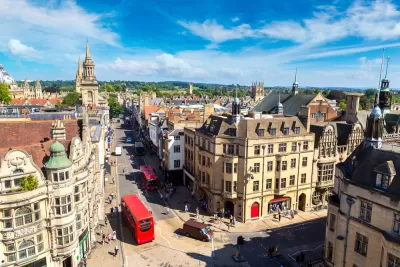Proposals for road diets, ‘15-minute cities,’ and other traffic reduction programs often meet with unfounded conspiracy theories claiming that the plans are nothing short of steps to world domination.

Pointing to an example from Oxford, England, The Guardian’s Peter Walker explores why conspiracy theorists are drawn to traffic calming plans, claiming there are more sinister reasons behind them.
According to the theories, promoted by far-right Canadian psychologist Jordan Peterson, among others, “Oxford’s traffic plan, they insist, is the first step in a global plot led by – depending on who you listen to – the World Economic Forum (WEF) or the UN, designed to strip people of their fundamental rights and personal possessions in the name of the environment.” Walker first debunks the claims. “It is worth stressing that no trip will be impossible, though some could be longer than before, with drivers instead having to use a less central route such as the city’s ring road.”
According to Walker, conspiracies connected to cars and traffic abound in part because “efforts to limit people’s right to drive, whether in previous years through residents’ parking zones, or more recently with low-traffic neighbourhoods, have often prompted a furious response, usually from a noisy minority.” These fears tie in with “climate conspirators,” who believe climate change is an elaborate scheme to bring the world under the control of an international cabal.
Why should we care about a small group of people believing absurd claims? “One significant worry is that people objecting to traffic restrictions can easily become exposed to much murkier ideas,” Walker explains.
FULL STORY: Why do traffic reduction schemes attract so many conspiracy theories?

Alabama: Trump Terminates Settlements for Black Communities Harmed By Raw Sewage
Trump deemed the landmark civil rights agreement “illegal DEI and environmental justice policy.”

Planetizen Federal Action Tracker
A weekly monitor of how Trump’s orders and actions are impacting planners and planning in America.

How Atlanta Built 7,000 Housing Units in 3 Years
The city’s comprehensive, neighborhood-focused housing strategy focuses on identifying properties and land that can be repurposed for housing and encouraging development in underserved neighborhoods.

In Both Crashes and Crime, Public Transportation is Far Safer than Driving
Contrary to popular assumptions, public transportation has far lower crash and crime rates than automobile travel. For safer communities, improve and encourage transit travel.

Report: Zoning Reforms Should Complement Nashville’s Ambitious Transit Plan
Without reform, restrictive zoning codes will limit the impact of the city’s planned transit expansion and could exclude some of the residents who depend on transit the most.

Judge Orders Release of Frozen IRA, IIJA Funding
The decision is a victory for environmental groups who charged that freezing funds for critical infrastructure and disaster response programs caused “real and irreparable harm” to communities.
Urban Design for Planners 1: Software Tools
This six-course series explores essential urban design concepts using open source software and equips planners with the tools they need to participate fully in the urban design process.
Planning for Universal Design
Learn the tools for implementing Universal Design in planning regulations.
Jessamine County Fiscal Court
Caltrans
Institute for Housing and Urban Development Studies (IHS)
City of Grandview
Harvard GSD Executive Education
Toledo-Lucas County Plan Commissions
Salt Lake City
NYU Wagner Graduate School of Public Service





























